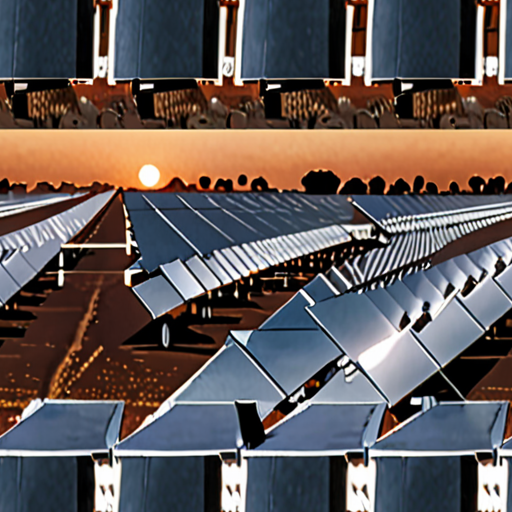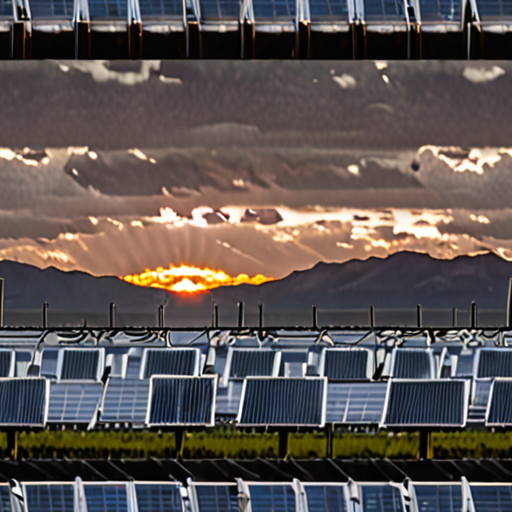In today’s world, where climate change and environmental degradation continue to pose significant threats, the need for eco-friendly energy production has never been more pressing. As we strive to reduce our carbon footprint and transition towards a more sustainable future, it’s essential to explore the most effective ways to harness renewable energy sources. From solar power to wind energy, hydroelectricity to geothermal power, there are numerous methods available to produce energy in an environmentally friendly manner. In this comprehensive guide, we’ll delve into the world of sustainable renewable resources, examining the benefits of eco-friendly energy production, the different methods of producing energy in an environmentally friendly way, and the most promising new energy technologies.

The Most Eco-Friendly Way to Get Energy
We’re constantly looking for ways to reduce our carbon footprint and live more sustainably.
- Solar Power: Harnessing energy from the sun is a clean and efficient way to power homes and businesses.
- Wind Power: Wind turbines convert wind kinetic energy into electricity, reducing reliance on fossil fuels.
- Hydroelectric Power: Tapping into the energy potential of moving water is a reliable source of renewable energy.
- Geothermal Power: Leverage heat from the Earth’s core to generate electricity and provide heating and cooling.
- Bioenergy: Convert organic matter into energy through various processes, such as anaerobic digestion or gasification.
- Hydrogen Fuel Cells: Produce electricity by combining hydrogen with oxygen, resulting in zero greenhouse gas emissions.
- Pumped Hydro Storage: Store excess energy generated by renewable sources for later use, helping stabilize the grid.
- Energy Efficiency: Improve the efficiency of existing infrastructure and appliances to reduce energy consumption.
- Tidal Power: Harness the predictable and powerful energy of ocean tides to generate electricity.
- Biogas: Capture methane produced during anaerobic digestion and utilize it as a renewable energy source.
At Pyrolysium, we believe in exploring innovative solutions to meet our energy needs while minimizing harm to the environment.
Key Considerations for Choosing Eco-Friendly Energy Sources:
- Renewable Energy Potential: Assess the availability and feasibility of renewable energy sources in your area.
- Economic Viability: Evaluate the cost-effectiveness of different energy options and consider incentives or subsidies.
- Environmental Impact: Weigh the ecological benefits and drawbacks of each energy source, considering factors like land use and resource extraction.
- Technological Advancements: Stay informed about emerging technologies and innovations that can enhance the efficiency and effectiveness of eco-friendly energy solutions.
Embracing Sustainable Energy Practices:
By prioritizing eco-friendly energy sources and adopting sustainable practices, we can create a cleaner, healthier planet for future generations.
Producing Energy in an Environmentally Friendly Way
We believe that renewable energy is the key to a safer future, and we’re committed to helping you understand its benefits.
- Renewable energy sources, such as wind and solar power, emit little to no greenhouse gases, making them a cleaner alternative to fossil fuels.
- These sources are also becoming increasingly cost-effective, with many countries investing heavily in renewable energy infrastructure.
- At Pyrolysium, we’re dedicated to educating and inspiring people about sustainable living and eco-friendly technologies, including pyrolysis – a process that transforms waste materials into valuable resources like biochar.
The Benefits of Renewable Energy
- Reduced Greenhouse Gas Emissions: Renewable energy sources produce significantly less greenhouse gas emissions compared to traditional fossil fuel-based power plants.
- Job Creation and Economic Growth: The renewable energy sector is creating new job opportunities and driving economic growth in many regions.
- Improved Air Quality: By reducing our reliance on fossil fuels, we can improve air quality and protect public health.
Competitors in the Renewable Energy Sector
While there are several companies working towards a more sustainable future, we believe that our approach at Pyrolysium sets us apart.
- SolarCity: A leading provider of solar energy solutions, SolarCity offers a range of products and services to help homeowners and businesses go solar.
- Vestas Wind Systems: As one of the world’s largest wind turbine manufacturers, Vestas is a major player in the renewable energy sector.
Our Approach to Sustainable Living
At Pyrolysium, we’re passionate about promoting sustainable living and reducing our environmental footprint.
- Education and Awareness: We believe that education and awareness are key to driving behavior change and promoting sustainable living.
- Innovative Technologies: We’re committed to developing and promoting innovative technologies that support sustainable living, including pyrolysis and biochar production.
- Community Engagement: We engage with local communities to promote sustainable living and provide educational resources and workshops.
Get Involved in Sustainable Living
Join us in our mission to promote sustainable living and reduce our environmental footprint.
- Learn More About Pyrolysis: Discover the benefits of pyrolysis and how it can support sustainable living.
- Get Involved in Our Community: Join our community and participate in educational workshops and events.
- Support Sustainable Living: Make a difference by choosing sustainable products and services.

What is the Most Environmentally Friendly Energy Source?
Solar energy, much like wind, is one of the most sustainable energy sources currently available.
- Renewable Energy Sources
- Solar energy harnesses power from the sun, converting sunlight into electricity through photovoltaic panels or solar thermal systems.
- Wind energy captures kinetic energy from wind turbines, generating electricity as the blades rotate.
- Hydro energy utilizes the movement of water in rivers, oceans, or tidal currents to drive turbines and produce electricity.
- Geothermal energy taps into heat from the Earth’s core, using it to generate steam and power turbines.
- Biomass Energy
- Biomass energy is produced from organic matter such as wood, crops, and waste, which is burned to generate electricity or heat.
- Biogas, a mixture of methane and carbon dioxide, is produced through anaerobic digestion of biomass, often used as fuel for vehicles or power generation.
- Nuclear Energy
- Nuclear energy generates electricity by splitting atoms in a nuclear reactor, producing steam to drive turbines.
- Fusion energy, still in its experimental stages, aims to replicate the process that powers the sun, offering a potentially limitless clean energy source.
- Other Sustainable Options
- Tidal energy harnesses the power of ocean tides to generate electricity, particularly suitable for coastal regions.
- Wave energy converts the motion of ocean waves into electrical energy, a promising technology for remote or off-grid locations.
When evaluating the most environmentally friendly energy source, consider factors such as greenhouse gas emissions, resource availability, and land requirements.
While solar and wind energy are leading contenders, other options like hydro, geothermal, and biomass energy also offer significant benefits.
As we continue to develop and innovate, fusion energy may become a game-changer in the pursuit of clean, sustainable energy.
Ultimately, a diversified energy mix that incorporates various renewable sources can help mitigate climate change and ensure a more sustainable future.

Examples of Sustainable Energy Production
We’re committed to reducing our carbon footprint and promoting environmentally friendly practices through innovative technologies.
-
Solar Power
Solar energy harnesses the power of sunlight to generate electricity, offering a clean and renewable alternative to fossil fuels. By investing in solar panels, we can significantly reduce greenhouse gas emissions and contribute to a more sustainable future.
-
Wind Power
Wind energy converts the kinetic energy of wind into electricity, providing a reliable and efficient source of renewable energy. As technology advances, wind turbines become increasingly cost-effective and environmentally friendly, making them an attractive option for powering homes and businesses.
-
Bioenergy
Bioenergy is derived from organic matter, such as wood, crops, and waste, which is converted into heat, electricity, or transportation fuels. This sustainable energy source reduces reliance on fossil fuels and decreases greenhouse gas emissions, promoting a cleaner environment.
-
Hydroelectric Power
Hydroelectric energy generates electricity from the movement of water in rivers, oceans, or man-made reservoirs. This renewable energy source offers a reliable and consistent supply of power, minimizing our dependence on non-renewable energy sources.
-
Tidal Energy
Tidal energy harnesses the power of ocean tides to generate electricity, providing a predictable and reliable source of renewable energy. By leveraging the natural movement of the tides, we can reduce our carbon footprint and promote sustainable development.
At Pyrolysium , we believe in embracing innovative technologies and sustainable practices to create a better future for generations to come.
The Most Sustainable Way to Generate Electricity
We believe that harnessing renewable energy is crucial for reducing our reliance on fossil fuels and mitigating climate change.
-
Solar Power
Solar panels convert sunlight into electricity, making solar power a clean and abundant source of energy. With advancements in technology, solar panels have become increasingly efficient and affordable, making them a viable option for homes and businesses alike.
-
Wind Power
Wind turbines harness the power of wind to generate electricity, offering a reliable and renewable source of energy. As technology continues to improve, wind turbines are becoming more efficient and cost-effective, making them a popular choice for many countries.
-
Hydroelectric Power
Harnessing the energy of moving water, hydroelectric power plants generate electricity by channeling water through turbines. This renewable source of energy is particularly effective in regions with significant water resources.
-
Geothermal Energy
Geothermal energy utilizes heat from the Earth’s core to generate electricity, providing a reliable and constant source of power. This renewable energy source is ideal for regions with significant geothermal activity.
-
Biomass Energy
Biomass energy generates electricity by burning organic matter such as wood chips or agricultural waste. While biomass energy has its drawbacks, it remains a viable option for regions with abundant organic waste.
-
Pyrolysis
Pyrolysis is a process that converts waste materials into valuable resources like biochar, providing a sustainable solution for waste management and energy generation. By leveraging pyrolysis technology, we can reduce greenhouse gas emissions and promote a circular economy.
At Pyrolysium, we’re committed to promoting sustainable energy solutions and reducing our carbon footprint. By investing in renewable energy technologies and adopting eco-friendly practices, we can create a cleaner, healthier environment for future generations.

Alternative Sources of Energy
We’re committed to exploring innovative ways to power our world sustainably.
-
Solar Energy
Solar energy harnesses the power of sunlight to generate electricity, reducing reliance on fossil fuels and lowering carbon emissions. With advancements in technology, solar panels have become increasingly efficient and affordable, making them a viable option for homes and businesses alike.
-
Wind Energy
Wind energy captures the kinetic energy of wind to produce electricity, offering a clean and renewable source of power. As wind turbines continue to improve in design and efficiency, they’re becoming a popular choice for large-scale energy production.
-
Hydro Energy
Hydro energy utilizes the power of moving water to generate electricity, often through dams or tidal power plants. This reliable and predictable source of energy has been harnessed for centuries, providing a significant portion of the world’s electricity.
-
Geothermal Energy
Geothermal energy taps into the heat of the Earth’s core to produce steam, which drives turbines and generates electricity. This renewable energy source is particularly well-suited for regions with significant volcanic activity or geothermal hotspots.
-
Bioenergy
Bioenergy converts organic matter – such as wood, crops, or wastewater – into usable forms of energy, including electricity, heat, or transportation fuels. This versatile energy source offers a promising solution for reducing greenhouse gas emissions and promoting sustainable land use.
-
Hydrogen Fuel Cells
Hydrogen fuel cells combine hydrogen with oxygen to produce electricity and water, emitting only heat and water vapor as byproducts. This zero-emission energy source holds great promise for powering vehicles, homes, and industries.
-
Tidal Energy
Tidal energy harnesses the predictable and powerful forces of ocean tides to generate electricity. By leveraging the rise and fall of sea levels, tidal energy systems offer a reliable and consistent source of renewable power.
Conclusion
As we strive towards a more sustainable future, it’s essential to explore and develop these alternative sources of energy. By investing in innovation and infrastructure, we can reduce our reliance on fossil fuels, mitigate climate change, and create a cleaner, healthier environment for generations to come.

0 Comments